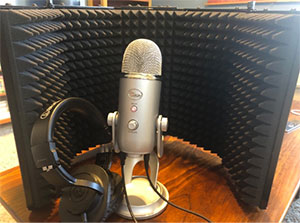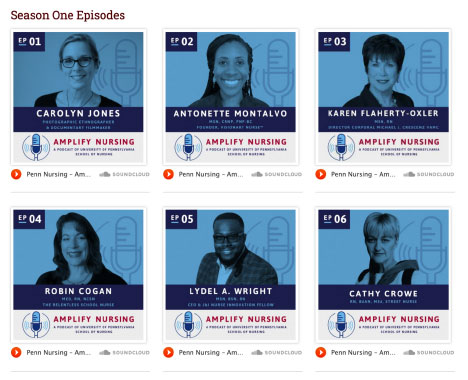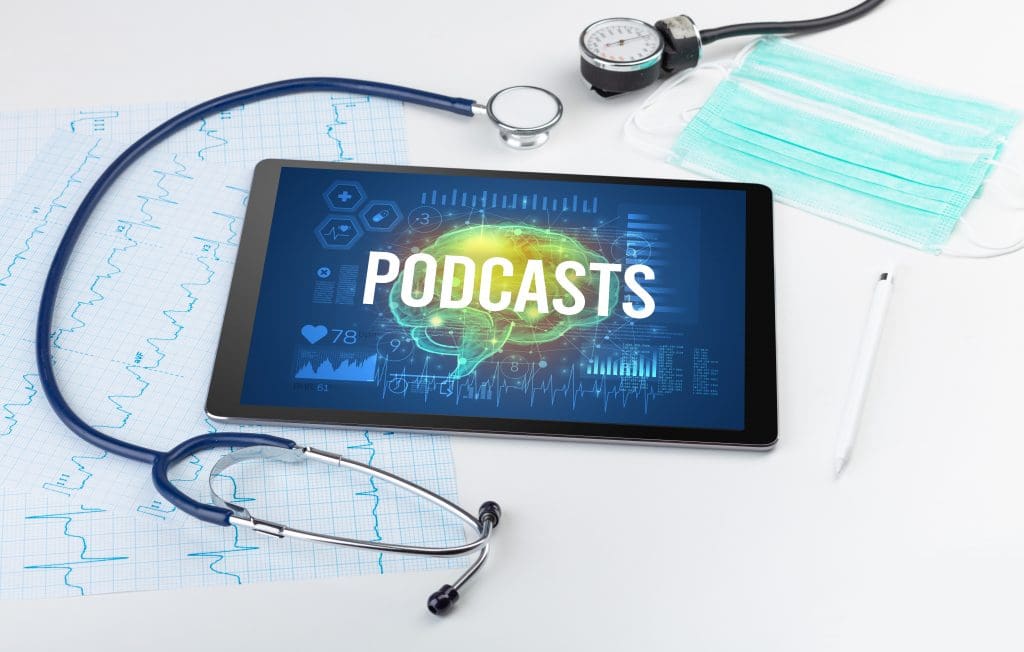There has been an influx of nurse-led podcasts over the past couple of years, which is great! I love nothing more than nurses using their expertise and creativity to push out their knowledge and voice to the world.
Podcasts can be a relatively easy way for nurses to share their stories, to give other nurses a platform to tell their stories, and to establish ourselves as the experts we are in the various areas where we work and practice.
I started podcasting many years ago thanks to a #STEM colleague, Chris Woods (aka @DailyStem). He hosted the STEM Everyday Podcast and was kind enough to offer me a guest segment on his show where I could feature women who were paving the way in science, technology, engineering, art & math (STEAM). The show was called STEAMrollrs, you can listen to all of the episodes here.
Having a guest segment on an established podcast is a great way to get your feet wet in the podcasting world, and to get a sense of what podcasting actually entails. I had no idea what I was doing back then, but it was a great opportunity to gain experience interviewing incredible women who really were paving the way in their respective fields.
The STEAMrollrs podcast only lasted one season, but I learned a tremendous amount during that time, skills I have since honed while hosting and producing the University of Pennsylvania’s School of Nursing podcast, Amplify Nursing, with my colleague Dr. Angelarosa Didonato.
I’d like to share some of what I’ve learned now as I firmly believe we need more nurses creating new and original podcast content. If you’re interested in podcasting, here are some things I think are important to consider.
- Decide what type of podcast you want to create. There are a number of different types of podcasts styles you can choose from, but I am just going to focus on some of the more popular ones: Interview style, commentary, nonfiction narrative, and fictional storytelling.
Interview-style
This is your straight-up 1:1 interview podcast, where you have a host who talks with a guest and asks questions (I mean, it’s in the name). This also could be categorized as Conversational style. The podcast I currently host, Amplify Nursing, and most current nurse-led podcasts, are this most basic type. For the Amplify Nursing podcast, we interview nurses who are leading the way in science, policy, innovation, and practice. We generally feature one guest on each episode, but this format also can be done with more than one guest. If you’re going to have more than one guest at a time, make sure you layout in advance how you’ll direct questions to each guest respectively so that they’re not talking over each other, as that makes for a much trickier post-interview edit! Multiple guests also can make episodes run longer — these are not necessarily bad things, they just need to be accounted for and planned for ahead of time.
This brings us to the second and third considerations, how long you want your podcast episodes to run (duration), and how often you want to release new episodes. More on these after we finish up with the different types of podcasts.
Commentary
Again, this is really self-explanatory, but a commentary-style podcast is where a host, or hosts, discuss a topic at length during an episode. They’ve picked a topic, researched it thoroughly, and are now talking to you, the listener, about said topic. One of my favorite podcasts that does this really well is Stuff You Missed In History Class. There are a few nurse-led podcasts that I would classify as more of a mix between commentary and interview style, including At The Core of Care. These podcasts include interviews with guest, but they also include in-depth commentary on an associated topic as well.
Nonfiction Narrative
The most famous nonfiction narrative storytelling podcast is This American Life. This type of podcast follows the story of an individual or topic throughout the episode. These types of podcasts are highly produced and include a lot of field reporting and “b-roll” audio. This is a much more complex style of podcasting that takes a lot more planning and resources. I’m only aware of one nurse-led podcast that classifies itself as nonfiction narrative, the Johnson & Johnson ANA podcast, SEE YOU NOW. Though they really classify themselves as “an entertaining storytelling adventure,” which I love and think should be a style all its own!
Fictional storytelling
Fictional storytelling in podcasts is a fairly new genre but this is where a narrator, or in more recent years, actors playing different roles, tell a story over a number of different episodes. It’s like an audiobook, but in episode form, created specifically for the podcast listening audience. I don’t know of any nurse-led podcasts that fit this category, but if you do, I would love to know about them. Seems like the old Cherry Ames fictional nurse series would be a great idea for this type of podcast (whoever owns the rights to that, let me know, I’d love to partner with you on this).
- How long you want your podcast episodes to run (run time or duration)?
This will depends on a number of things, including the type of podcast you’re creating, the layout of your podcast, and your topic and/or focus area. For the Amplify Nursing podcast, the average duration of our episodes is 35 minutes. In general, the average podcast duration is 43 minutes.
- How frequently do you want to release new episodes?
So many things come into play for this question—the type of podcast you’re creating, the financial and human power support you have to put the different components of the podcast together, and how frequently you can push out fresh content. We release a new Amplify Nursing podcast every other week for a number of reasons, but first and foremost because the podcast isn’t our full-time job and it takes a lot of time and energy to interview, edit, and produce.
- What kind of equipment do you need?
At a minimum, you need a good microphone, but there are many other things that will heighten the quality of your podcast, including a good pair of headphones and a Sound-absorbing Cover and/or Sound Insulation Screen. If you’re starting a podcast, I suggest talking with a sound engineer and/or podcast producer to gain a better understanding of all of the equipment needs.


It’s also important to think about where you’ll record your podcast; obviously, it should be in as quiet a room as possible. Pre-COVID we were recording Amplify Nursing in a podcasting studio on campus. Since COVID, we’ve been recording at our respective homes—me in my family room and my co-host in her bedroom. For me, my family room is one of the few rooms in my house that has carpet and isn’t facing the busy city street. It’s not perfect, but most people have come to accept that the quality of podcasts will vary, especially during COVID. It’s helpful if your guests also have a quality microphone, but that rarely happens.
Pro-tip: I also make sure to ask our guests to close their email inboxes, Slack or any other programs that will “ding” when they get a new notification. I don’t mind dogs barking at all (in fact, I kind of love when that happens), but I really don’t like when things “ding”.
- What kind of podcasting program do you want to use?
There are podcasting programs that can be used to record and edit. We had been trying to use SquadCast, but since we transitioned to our homes, it wasn’t as stable as Zoom, so now we just record our interviews on the Zoom platform. We do part of our editing and recording on GarageBand (which I have a love-hate relationship with), and then send anything more complex to our Information Technology Services colleague at Penn Nursing to edit and then mix in the various components.
- What kinds of components do you want for your podcast?
For our interview-style podcast, we always open with an audio track of the guest saying a quote that we think sets the stage for the conversation. We then include our Amplify Nursing Intro, which is the same for every episode. It explains who we are and what the podcast is all about. After that, we include an introduction of our guest, a short bio, and a description of what lays ahead in our conversation. After the interview, we (the co-hosts) have a quick conversation together talking about our favorite parts of the interview, and then we end with our standard Outro, which again, is the same for every episode—we thank our team and sponsors and end by asking people to please share, rate, and review us. Every so often we also include a promo or advertisement of other podcasts somewhere in the middle of the episode.
A promo swap is where similar podcasts promote each other to generate new listeners. We’ve also done what I like to call podcast cross-over events, where we cover similar topics with another podcast; that way our respective listeners can learn even more about a topic from multiple podcasts — and again, it increases our listenership and advertises our podcast to a new audience.
- Where do you want to host your podcast?
Where to host your podcast is an important consideration because certain hosting sites have restrictions on what they can and can’t do. For example, we host our podcast on SoundCloud. Unfortunately, SoundCloud has its limitations — we’d like to always have our Amplify Nursing podcast promo spot at the top of our iTunes page, but SoundCloud doesn’t allow for that option. There are creative ways around that, but this is something to consider when choosing your hosting platform.
- Get your podcast on as many platforms as possible.
Where your podcast is listed is important — and getting new episodes pushed out is relatively easy using the RSS feed on your hosting site. Therefore, including your podcast on as many platforms as possible is key, you just need to make sure you fill out the submission form for each. Amplify Nursing is available on iTunes, Spotify, GooglePlay, Stitcher, iHeart Radio, or wherever you do your podcast listening! Each new episode is uploaded to SoundCloud and then automatically pushed out to those platforms, as well as the Health Podcast Network, of which we’re a member.
The Health Podcast Network “features authoritative shows, hosts and guests who take on the tough topics in health and care with empathy, expertise, and a commitment to excellence.” They have an entire section on nurse-led podcasts that has grown significantly in the short time Amplify Nursing has been a member. It warms my heart to see!
- Other considerations: Name and graphics.
Your name should be creative and relatable — and easy to find on the various podcast sites. You want it to be unique but also reflect what your podcast is all about.
Branding your podcast also is key. You want to think about your graphics and other creative ways to advertise so when people see your logo, they automatically think of your podcast. Luckily at Penn Nursing, we have a graphic designer we work with in our marketing and communications department to help us create the Amplify Nursing brand and new graphics for each episode. If you don’t have a professional graphics person to work with there are a number of ways to create engaging content, including using online programs such as Canva or other graphic design platforms.
We also use Headliner to create audiograms, which incorporate a graphic along with a selected audio clip from a specific podcast episode. You also can include the text of the audio clip with a waveform as well. It is just one way to make your graphics engaging while highlighting a component of the podcast.
- A content calendar is key!
As I mentioned, we release a new episode of the Amplify Nursing podcast every other week. For that to happen, we plan out a content calendar that includes who we’re interviewing, when we’re interviewing them, and when their episode will be released. It takes about a week to record, edit, and produce each episode and get the graphics created (as I mentioned, we all have other responsibilities, we’re not full-time podcasters). That may seem like a lot of time, but it comes around fast, so having interviews lined up ahead of time helps ensure we don’t have to scramble to get an episode out or miss a week!
Step-by-step guide to posting a new podcast episode.
After we have all of our components created and edited, the first step to releasing a new episode is to upload the audio file to SoundCloud, and create the SoundCloud track page with title, description, and graphic (along with a number of other things including hashtags). After the episode is uploaded to SoundCloud and released publicly, it gets pushed out to all of the podcast sites where we’re listed via the RSS feed. We also upload the episode and graphics to our Penn Nursing website and embed the SoundCloud audio file there for easy listening. Finally, we create an audiogram for each new episode and use that to promote the episode on social media. And voila, you have a new episode out to the airwaves!
Amplify Nursing Podcast
Season 1 of the Amplify Nursing podcast launched in February 2020 and concluded in August 2020. In that time, we released 24 total episodes:13 regular-season episodes; 10 special episodes focused on the coronavirus pandemic and racial justice, and health inequity; and 1 bonus episode. This were way more episodes than we had planned, but then nothing about 2020 was how anyone had planned!


Season 2 launched in November 2020 and currently includes 7 episodes including our most recent episode with Patrick McMurray. You can check out all of the Amplify Nursing podcast episodes here.
If you’re interested in listening to more nurse-led podcasts, check out this crowdsourced list on Google Docs that includes over 50 nurse-led podcasts. Please feel free to add others as you hear of them!
Hosting and producing a podcast is not as easy as I may have led you to believe at the beginning — it includes a lot of planning and a ton of work, but it’s also a lot of fun and a great way to amplify the work you and other nurses are doing. The more nurses we have sharing their voice and knowledge out in the world, the better for everyone! So go out, use your voice, amplify others’ voices, and get your nurse-led podcasting on! I can’t wait to listen.
If you’d like to listen to a podcast episode of this article, you can listen here!
https://soundcloud.com/penn-nursing/nursing-led-podcasting-to/s-jML9cMnLfRR


















